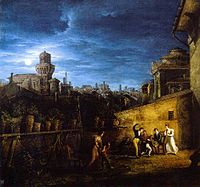Antonio Basoli
Antonio Basoli | |
|---|---|
Emilia Romagna | |
| Nationality | Italian |
| Years active | 1801-1842 |
Antonio Basoli (1774–1848) was an Italian painter, interior designer, scenic designer, and engraver, active mostly in Bologna.
Biography
He was born in
Works
In 1801–1803, he painted frescoes at a few sites in the Friuli, including casa Muratori in Trieste and a palace in Spilimbergo.

Basoli worked as a set and curtain (sipario) designer, as well as decorator for various theaters around Bologna such as the Marsigli Rossi Theater, the
Basoli was also offered commissions for scenography from theaters in Rome in 1815, and from Naples, by request of
Among his exhibitions at the Academy of Bologna were a collections of
Typical of his designs, merging art and erudition, he later created 26 vignette compositions, depicting an archeologic alphabet in form of watercolors, called his Alfabeto pittorico.[5]
Publications
- Raccolta di prospettive serie, rustiche e di paesaggio (1810)
- Guarnizioni diverse di maniera antica (1814)
- Porte della città di Bologna (1817)
- Esemplare di Elementi d'Ornato che contiene lo studio della pianta d'accanto (1817)
- Collezione di varie scene teatrali (1821)
- Compartimenti di camere (1827)
- Vedute pittoresche della città di Bologna (1833)
- Definizioni geometriche (1837)
- Raccolta di diversi ornamenti (1838)
- Alfabeto pittorico (1839)
References
- Basoli, Antonio (2006). La vita artistica di Antonio Basoli. Bologna: Minerva Edizioni. 9788873811527.
- Basoli, Antonio (1969). Collezione Di Varie Scene Teatrali. New York: Benjamin Blom.
- Smithsonian Museum, collection of Basoli's works.
- ^ a b "Antonio Basoli | Artnet".
- ^
Antonio Basoli: Ornatista, Scenografo, Pittore di paesaggio. Minerva Edizioni. 2008. p. 31. ISBN 978-88-7381-208-1. Archived from the originalon 18 February 2013.
- ^ Image artearti.net
- ^ ISBN 978-88-7381-208-1. Archived from the originalon 18 February 2013.
- ^ Memoria di Bologna short biography by Roberto Martorelli.
- ^ Image artnet.com
External links
- Comune (municipality) of Castel Guelfo di Bologna Antonio Basoli, ornatista, scenografo, pittore di paesaggio – exhibition at the Pinacoteca Nazionale di Bologna 15 April 2008 in collaboration with the comune (municipality) of Bologna [1].
- Link to over 200 pictures of Basoli's work [2].
- Basoli's Alphabet [3].
